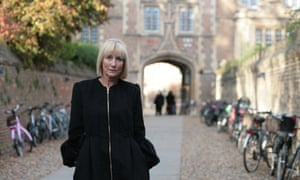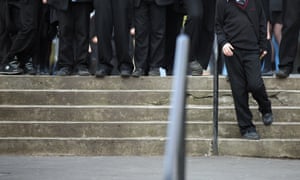
When Diane Reay, Cambridge University professor of education, started researching her book about working class children’s experiences of education, she had no idea just how much inequality she would uncover in state schools today. “The most important thing I found out was that we are still educating different social classes for different functions in society.”
She expected to find the English state system was providing roughly the same education for all. “But it doesn’t. Even within a comprehensive school, when they’re all in the same building, the working classes are still getting less education than the middle classes, just as they had when my dad was at school at the beginning of the 20th century.”
Reay’s background informs her book and her opinions. The daughter of a coalminer, and the eldest of eight, she grew up on a council estate and received free school meals. She then spent 20 years working as a teacher in London primary schools before moving into academia and ending up at Cambridge.
“My parents had a strong sense that the educational system hadn’t been fair to them and they had missed out. I learned as a small child I had to work at least twice as hard as the middle class children to achieve the same result. When I did show ambition – to go to LSE [the London School of Economics and Political Science] to be a political researcher – I was told it wasn’t appropriate.”
How much has changed? “This government is making inequality in education worse, not better,” she says.
Reay carried out more than 500 interviews and identified most with the children who were difficult and out of place: the “fighters”, she calls them. “That was the sort of child I was in school.”
Now she hopes to open up a national debate about what a socially just education would look like. “There’s this incessant babble from the government about social mobility. But the academy and free school movement has made things worse for working class children, with more segregation and polarisation.” In spite of free schools and academies receiving more funding per pupil than state comprehensive schools, they typically educate fewer children in receipt of free school meals, she found. “Free schools and academies have a more advantaged intake than the comprehensive schools do.”
England does not have an education system that is serious about realising the potential of all children, she argues, with those on free school meals and receiving pupil premium 27% less likely to achieve five or more GCSEs at grades A*-C including English and maths. Four-fifths of children from working-class minority ethnic families are taught in schools with high concentrations of other immigrant or disadvantaged students – the highest proportion in the developed world, according to a report by the Organisation for Economic Cooperation and Development. Half of all free school meal children are educated in just a fifth of all schools.
“There are predominantly middle class comprehensives and predominantly working class and ethnically mixed comprehensives – and despite all the rhetoric around pupil premiums, pupils in the more working class comprehensives get less money per head. They get less qualified teachers. They get higher levels of teacher turnover and more supply teachers. Even if they are in the same schools as middle class children, they are in lower sets and yet again they get less experienced teachers.”
All the children she interviewed had a powerful sense of their position in the academic hierarchy. “Right from reception now some children are in sets aged four and they can tell they’re only in ‘the monkeys’ and that’s not a very good group to be in. That means they’re not very clever.” She was shocked by the anxiety displayed by very young children, who, she says, blame themselves if they are put in the lower sets.
Research suggests it is the wealth and inclination of parents, rather than the ability and efforts of the child, that have the most bearing on a child’s educational success today. “If you’re a working class child, you’re starting the race halfway round the track behind the middle class child. Middle class parents do a lot via extra resources and activities.”

Less affluent children also get a more restrictive educational offer, she discovered. “It wasn’t until I talked to young people about their experiences that I realised how different and unequal their educations were. Because the schools that working class children mostly go to are not doing well in the league tables, there’s a lot of pressure on their teachers and heads to increase their league table position. That means they focus ruthlessly on reading, writing and arithmetic.”
Some children in these schools talked wistfully about hardly ever doing art, drama or dance: “These children come from families where their parents can’t afford to pay for them to do those activities out of school. It almost feels criminal. It feels very unfair.”
The difference between amounts spent on educating children privately or in the state sector is stark. She cites research from University College London that found £12,200 a year is the average spending on a privately educated primary pupil, compared with £4,800 on a state pupil. For secondary, it’s £15,000 compared with £6,200.
“Society has got more unfair, and the gap between the rich and poor is a lot greater than it was even 30 years ago. We’ve got to move back instead of going further in the direction of austerity, which seems to be punishing the poor.”
She believes the government’s support for academies and free schools is powerfully ideological. “It’s about opening up education to the markets. I found it particularly shocking – and I had to read some quite boring parliamentary reports to get the information – that masses of money has gone into the academy and free school programme, and it’s been taken out of the comprehensive school system.”
Reay found that free schools receive 60% more funding per pupil than local authority primaries and secondaries, and that £96m originally intended for improving underperforming schools was redistributed to academies.
To make things worse, an analysis of Department for Education data reveals that schools with the highest numbers of pupils on free school meals are facing the deepest funding cuts: in secondary schools with more than 40% of children on free school meals, the average loss per pupil will be £803. That’s £326 more than the average for secondary schools as a whole. And primary schools with high numbers of working class pupils are expected to lose £578 per pupil.
Another blow being inflicted on working class children is through the way they are treated in some super-strict schools, argues Reay. She says some academies operate on the principle that working class families are chaotic and children need school to impose control. “There’s lots of lining up in silence, standing to attention when an adult comes into the room, and mantras. I think it’s about disrespecting working class young people and their families.
“There’s one academy where the children have to say: I aspire, he aspires, she aspires, we all aspire.”
Another issue is widespread setting and streaming. “There’s masses of research that shows it doesn’t work – that, actually, if you put children in mixed ability groups, the majority make greater progress.
“Plus, research on wellbeing shows that you need to decrease the social distance between people. There’s mistrust, wariness and anxiety about people who are different from us. That obviously came out in the Brexit vote. If you put children together in their classroom, they start to learn that what they share is much greater than the differences between them.”
After her own schooling at Ashby grammar school, Leicestershire, Reay went to Newcastle University to study politics and economics before getting a job as a primary teacher in Islington. She took her master’s in 1985 at the Institute of Education then went back to teaching. She was he main breadwinner in her family, and managed to get funding to do a sociology PhD at South Bank University when she was in her mid-40s.
She took up her first research post at King’s College London a few years later and in 2001 was given a chair at the Institute for Policy Studies in Education at London Met. After collaborating on a research project on school inclusivity with academics at Cambridge, she was asked to apply for her current job in the faculty of education in 2004. “If I hadn’t worked with colleagues at Cambridge already, I don’t think I’d have dared.”
As a Cambridge professor, she is also highly critical of Oxbridge’s failure to attract students from working class backgrounds and ethnic minorities. But lowering entry requirements is not the solution, she believes. “Focus just at the admissions level isn’t really going to change very much. We’re never going to have a critical mass of those students who are non-traditional to make a difference.”
Instead of blaming non-traditional students for not applying, which she finds hypocritical, she’d like the elite universities to look at their whole culture and ethos. “Maybe they need to ask: how can we make ourselves more attractive to non-traditional applicants? The courses, for example, need to be brought into the 21st century, instead of staying in the 17th.”
She was feeling positive that a debate about the diversity of Cambridge University reading lists was opening up – until the Telegraph ran its inaccurate front page story claiming a black student, Lola Olufemi, was forcing the university to drop white authors from its syllabus. “That poor woman was subject to so much negative feedback. The attitude of the Telegraph was: who does she think she is?”
Reay says she felt compelled to write this book because she believes things cannot go on as they are. “There needs to be a sea change in public opinion, for us to say this is too inequitable and unfair. There needs to be a new collective effort to make things fairer.”
Miseducation: Inequality, education and the working classes by Diane Reay (£12.99) can be ordered from the Guardian Bookshop
Source;-theguardian












